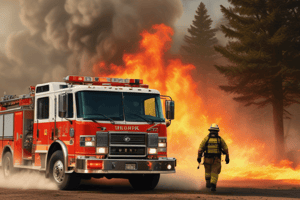Podcast
Questions and Answers
In which mode should the IC assign the remainder of the crew to staff functions to assist the IC?
In which mode should the IC assign the remainder of the crew to staff functions to assist the IC?
- Command Mode (correct)
- Investigative Mode
- Fast Attack Mode
- None of the above
What type of personal protective equipment (PPE) should personnel be in, according to the text?
What type of personal protective equipment (PPE) should personnel be in, according to the text?
- Rescue gear
- Staff functions gear
- Investigative gear
- Firefighting gear (correct)
When is it appropriate for the IC to engage in firefighting operations?
When is it appropriate for the IC to engage in firefighting operations?
- When in Fast Attack Mode (correct)
- When in Investigative Mode
- When in Command Mode
- None of the above
What should the IC do after establishing command and locating a command post?
What should the IC do after establishing command and locating a command post?
What should the IC do after declaring Command Mode?
What should the IC do after declaring Command Mode?
When should command be transferred between the initial IC and the qualified officer assuming command?
When should command be transferred between the initial IC and the qualified officer assuming command?
What information should the first arriving department unit provide to Dispatch?
What information should the first arriving department unit provide to Dispatch?
What is the primary responsibility of the Incident Commander (IC) during the first five minutes?
What is the primary responsibility of the Incident Commander (IC) during the first five minutes?
What does the term 'reactive mode to proactive mode' refer to in the context of incident stabilization?
What does the term 'reactive mode to proactive mode' refer to in the context of incident stabilization?
Where should apparatus not immediately required for stabilization of the scene stage?
Where should apparatus not immediately required for stabilization of the scene stage?
Flashcards are hidden until you start studying
Study Notes
Incident Command
- The IC should assign the remainder of the crew to staff functions to assist the IC in Complex Mode.
- Personnel should be in full personal protective equipment (PPE).
Incident Stabilization
- The IC should engage in firefighting operations only when life or property is immediately threatened.
- After establishing command and locating a command post, the IC should conduct a size-up, identify hazards, and implement a plan.
Command Mode
- After declaring Command Mode, the IC should assign tasks, monitor progress, and adjust the plan as needed.
Command Transfer
- Command should be transferred between the initial IC and the qualified officer assuming command when the qualified officer is fully briefed and assumes responsibility.
Initial Response
- The first arriving department unit should provide scene size-up, location, and resource requirements to Dispatch.
Primary Responsibility
- The primary responsibility of the Incident Commander (IC) during the first five minutes is to ensure scene safety and stabilize the incident.
Incident Stabilization Mode
- The term 'reactive mode to proactive mode' refers to the transition from initial response to planned and coordinated actions.
Apparatus Staging
- Apparatus not immediately required for stabilization of the scene should stage at a safe distance, awaiting further instructions.
Studying That Suits You
Use AI to generate personalized quizzes and flashcards to suit your learning preferences.





